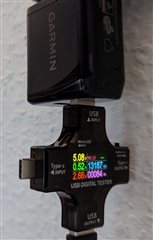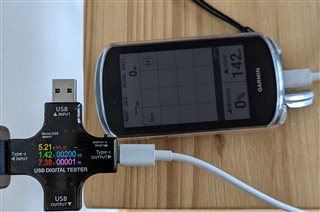Charging my Edge 1040 with the Garmin USB-A wall-charger, works with 0.5 ampere / 2.5 watts. Battery was down to 30%.
Charging with an USB-A computer-port it is also with 0.5A.
These are the charging methods described in the manual.
For a short test I connected the Edge with a USB-C PD charger, and charging was with 1.4 ampere / 7W (using a Anker 711 Nano II Charger and a Anker USB-C to USB-C charging cable).
My question: is this a save and recommended way to charge?
Also I noticed that that charging with 3rd-party USB-A chargers results in 1A / 5W charging.
Test results:
Charging USB-A with the Garmin 5V / 2.4A charger (model 010-13023-02).

Charging USB-A with a Belkin 5V / 2.4A charger

Charging USB-C PD:

Summary:
- Charging with original Garmin USB-A charger and Garmin cable is at 0.5A only (but charger supports up to 2.4A)
- Charging with computer on USB 2.0 USB-A port with Garmin cable ist at 0.5A
- Charging with computer on USB 3.1 USB-A port with Garmin cable ist at 0.5A (but port supports up to 0.9A)
- Charging with all other USB-A chargers I tested is always at 1A (chargers from Belkin, Samsung, and Apple used)
- Charging with with computer on USB 3.2 Gen1 USB-C port is at 1.3 A
- Charging with a USB-C PD charger using USB-C to USB-C cable is at 1.4 A
- Charging when powered off is ALWAYS with exactly 0.36A nomatter what charger used
The Garmin-recommended charging methods: original cable on either a USB-A computer-port or the Garmin-charger results in 0.5A-charging.
Using 3-party USB-A chargers or a USB-C PD charger results in 1 to 1.4A charging (2 to nearly 3 times more).

